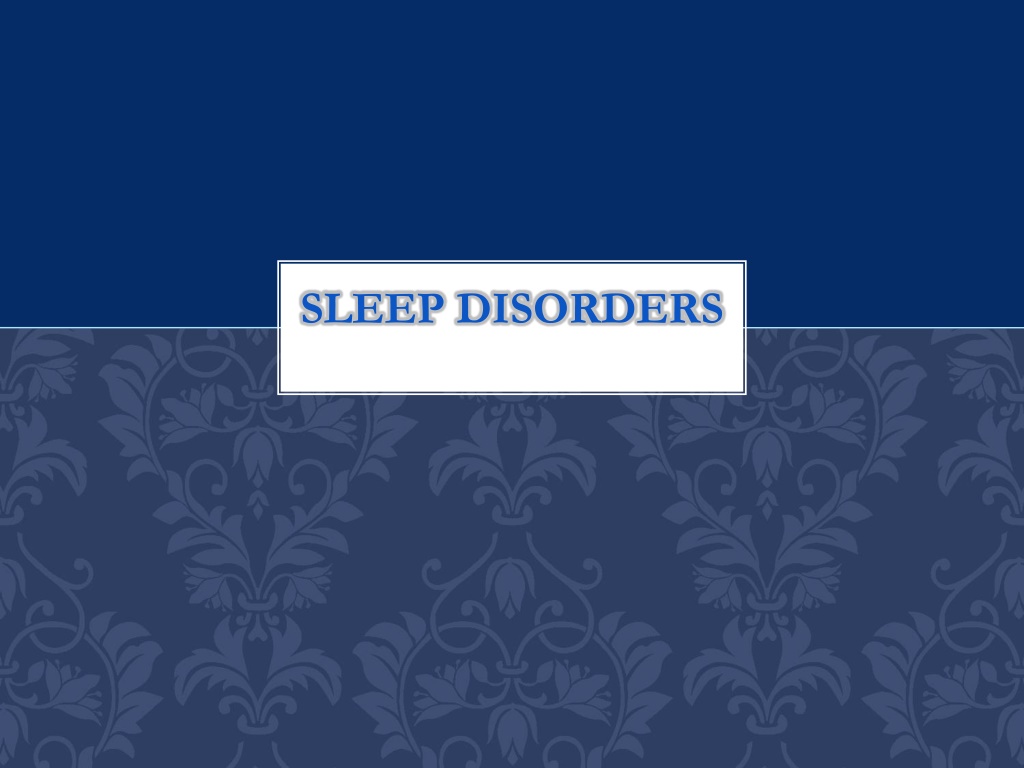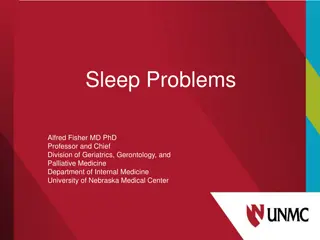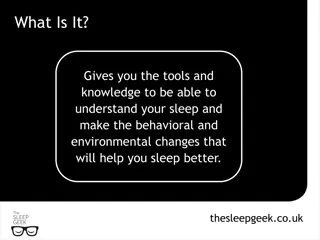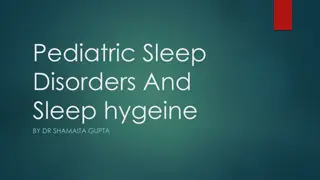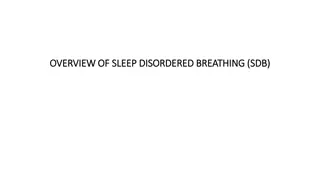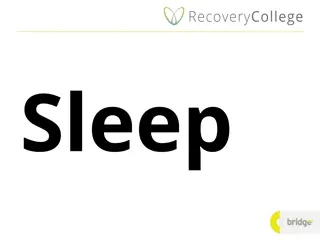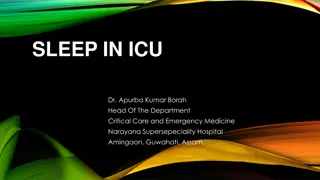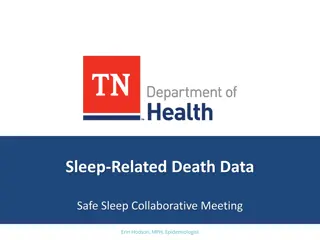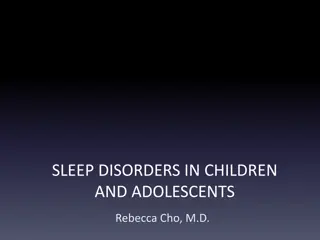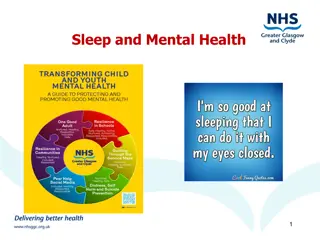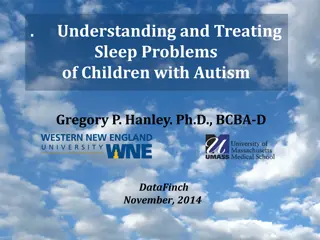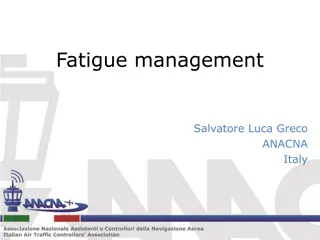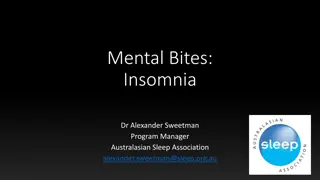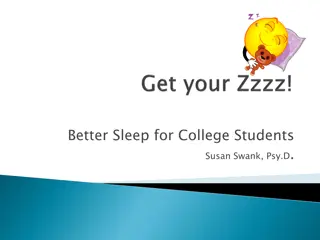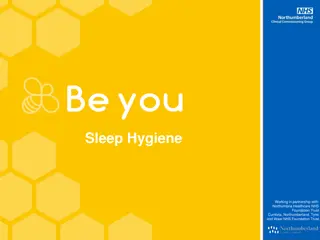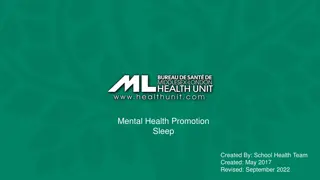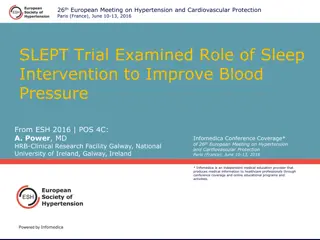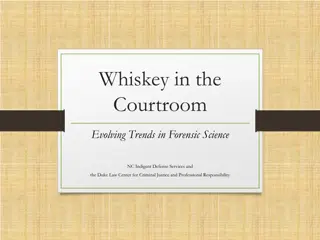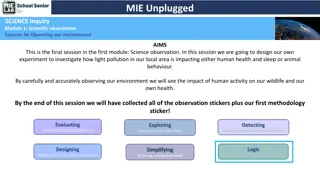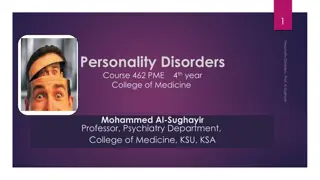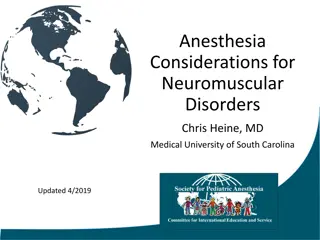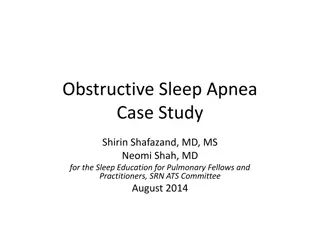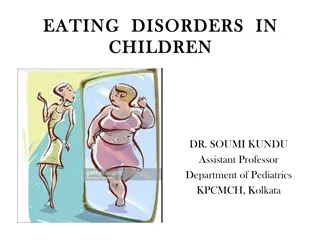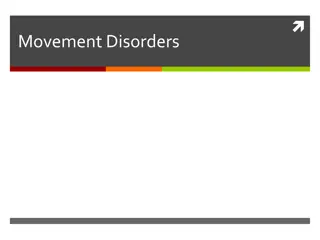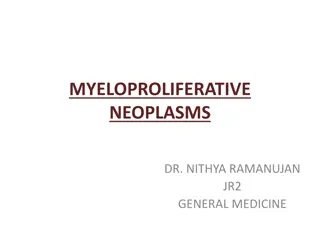Overview of Common Sleep Disorders and Their Classification
Sleep disorders such as insomnia, restless leg syndrome, obstructive sleep apnea, parasomnias, and narcolepsy are prevalent conditions that affect the quality and pattern of sleep. Insomnia is characterized by difficulty initiating or maintaining sleep and is more common in females and older individuals. Restless Leg Syndrome involves an irresistible urge to move limbs, obstructive sleep apnea results from upper airway obstructions, parasomnias include abnormal behaviors during sleep, and narcolepsy leads to uncontrollable daytime sleepiness and cataplexy. These disorders have varying prevalence rates and underlying causes, impacting overall health and well-being.
Download Presentation

Please find below an Image/Link to download the presentation.
The content on the website is provided AS IS for your information and personal use only. It may not be sold, licensed, or shared on other websites without obtaining consent from the author. Download presentation by click this link. If you encounter any issues during the download, it is possible that the publisher has removed the file from their server.
E N D
Presentation Transcript
CLASSIFICATION According to their prevalence, sleep disorders are classified into: 1- Insomnia (the commonest): difficulty in initiating or maintaining sleep. 2- Restless Leg Syndrome (RLS) 5-15%: 3- Obstructive Sleep Apnea (OSA) 4% 4- Parasomnias. 5- Narcolepsy.
INSOMNIA It is the difficulty in initiating or maintaining sleep. Insomnia increases with age (1/3 of people> 65years) have persistent insomnia. female > male.
RESTLESS LEG SYNDROME (RLS) Irresistible desire to move the limbs especially at rest and therefore can make it hard to sleep. If occur during sleep it is called Periodic Limbs Movements of Sleep (PLMS). Results from iron deficiency in the brain lead to dysfunction of dopaminergic substantia nigra. Prevalence increases in Parkinson's disease, diabetes mellitus, rheumatoid arthritis and pregnancy. transmission in the end stage renal disease,
OBSTRUCTIVE SLEEP APNEA (OSA) Common type of sleep apnea and is caused by complete or partial obstructions of the upper airway Present as repetitive upper airway collapse during sleep, which decreases or stops airflow, with subsequent arousal from sleep to resume breathing. Characterized by snoring, choking, gasping for air and morning headache. It is usually associated with: Obesity and this will also contribute to CV diseases. Smoking: by increasing upper airways edema.
CONT. Hypertension, hypoxemia sympathetic nervous system activity. heart and failure, hypercapnia and stroke which because increases
PARASOMNIAS Involve abnormal movements, behaviors, emotions, perceptions, and dreams that occur while falling asleep, sleeping, between sleep stages, or during arousal from sleep. Eg. sleep walking, sleep talking, bruxism (grinding teeth) and enuresis. More frequent in children
NARCOLEPSY Un-controlable desire for sleep at daytime (decreased ability to regulate sleep-wake cycles). Often associated with cataplexy (abrupt attack or episode of muscle weakness). Here the conc. of hypocretin due to autoimmune destruction (a wake promoting reduced in the CSF. neuropeptide) is
DIAGNOSIS To diagnose sleep disorders, clinical history is the main way, but overnight polysomnography &/or Multiple Sleep Latency Test (MSLTs) can diagnose for OSA, narcolepsy, & PLMS. Polysomnography: is a comprehensive recording of the biophysiological changes that occur during sleep, it can monitors many body functions including brain (EEG), eye movements (EOG), muscle activity or skeletal muscle activation (EMG) and heart rhythm (ECG) during sleep.
DIAGNOSIS Multiple Sleep Latency Test: It is used to measure the time elapsed from the start of a daytime nap period to the first signs of sleep, called sleep latency. The test is based on the idea that the sleepier people are, the faster they will fall asleep. Minutes 0-5 5-10 10-15 15-20 Sleepiness Severe Troublesome Manageable Excellent
PHYSIOLOGY OF SLEEP Normally human sleep 1/3 of their lives This is necessary to maintain wakefulness and health. Most people sleep 7-8hr/day. Some healthy subjects require as little as 3 hr/d. Sleep requirement decrease with age (physiological insomnia) and it does not cause daytime fatigue.
Sleep is government by the suprachiasmic nucleus in the brain which regulates the circadian rhythm
STAGES OF SLEEP Rapid eye movement (REM) 25% of sleeping time paradoxical sleep, eye movement and dreaming occur but the body is mostly virtual paralyzed. REM sleep is turned on by acetylcholine secretion and is inhibited by neurons that secrete monoamines including serotonin. REM sleep occurs as a person returns to stage 2 or 1 from a deep sleep. Non- REM sleep 75% of sleeping time (3 stages; N1, N2 & N3). body activity slows down: body temperature, heart rate, breathing rate, and energy use all decrease. Brain waves get slower and bigger, and the excitatory neurotransmitter acetylcholine becomes less available in the brain.
ETIOLOGY OF INSOMNIA Insomnia could be either: Primary insomnia (rare) no contributing factor. Secondary insomnia (frequent), a symptom of an underlying disease. Stress, pain, thyroid abnormality, asthma, depression, bipolar disorders, or drugs: SSRIs, steroids, stimulants, agonists, withdrawal of CNS depressants after chronic use (hypnotics, anxiolytics, alcohol).
PATHOPHYSIOLOGY OF INSOMNIA Certain wakefulness in different areas in the CNS: Serotonin: controls Non-REM. Cholinergic, adrenergic transmitters: REM sleep Dopamine Norepinephrine Hypocretin play a role in wakefulness Substance P Histamin neurotransmitters promote sleep and
CLINICAL PICTURE OF INSOMNIA Difficulty falling a sleep Frequent nocturnal awaking. Early morning awaking. Resulting in daytime impairment in conc. and work performance.
TREATMENT OF SLEEP DISORDERS INSOMNIA Non pharmacological 1- Regular sleep schedule. 2- Exercise but not before bed time. 3- Avoid alcohol or caffeine. 4- Quite dark place to sleep. 5- Avoid daytime naps.
PHARMACOLOGICAL TREATMENT OF INSOMNIA First :- Benzodiazepine receptor agonists BZDRAs These occupy the benzodiazepine receptors on the GABA type A receptor and facilitate the inhibitory effect of GABA in the brain and promote sleepiness. Transitional benzodiazepines: diazepam, lorazepam, temazepam. The Z- drugs (nonbenzodiazepine hypnotic) Zaleplon, zopiclon, zolpidem.
Flurazepam: high risk for hangover and residual effects. Temazepam: moderate duration well tolerated inexpensive. Eszopiclone: can be used for 6 months for chronic insomnia. Zopiclone: less alteration in sleep stages, used for 2-4 weeks, can be used for chronic insomnia. Zaleplon: short acting only for difficulty falling asleep, causes late night rebound insomnia. Zolpidem: short-moderate duration no effect on sleep stages. Because of short t1/2, hangover effects are rare, but rebound insomnia in late night causing early morning waking.
Z DRUGS All the Z- drugs are expensive and used for short term Start with minimum effective dose, and increase if necessary and the dose should be reduced in: Elderly Hepatic diseases Respiratory diseases Pharmacologic treatment of insomnia is recommended for short term only (2-4weeks), but long term use of hypnotics is not CI unless other CI is present.
ADVERSE EFFECTS OF BENZODIAZEPINES 1- Residual sedation(hangover): minimized by careful selection of hypnotic agent with a duration of action matching the sleep time of the patient. 2- Anterograde amnesia: partial or complete inability to recall the recent past. avoid a drug with active metabolite like flurazepam for elderly. 3- Rebound insomnia: especially after discontinuation of short duration BZD. 4- Tolerance, dependence, withdrawal: reduced by intermittent therapy with lowest possible dose. 5- DI: alcohol, TCAs, antihistamines, opioids causing marked sedation or respiratory depression.
Second: Sedating antidepressants: Trazodone, amitriptyline. These are good when insomnia is associated with depression. But have frequent side effects Especially when used for elderly.
Third: Antihistamines: Diphenhydramine, chlorpheneramine Used for chronic insomnia. Also produce undesirable side effects
Forth: Ramelteon A new melatonin receptor agonist, that selectively binds to the MT1 and MT2 receptors in the suprachiasmatic nucleus (SCN), instead of binding to GABA A receptors. Indicated for insomnia characterized by difficulty with sleep onset. Ramelteon is not a controlled substance, and thus may be a viable option for patients with history of substance abuse.
INSOMNIA IN ELDERLY PATIENTS Are vulnerable both to insomnia and to adverse effects of hypnotics because: a. Reduced met. of some drugs. b. Have other diseases (eg CV). c. Sensitive to respiratory depression. d. Prone to sleep apnea. Therefore we should: a. Adjust hypnotic dose (1/2 the recommended adult dose). b. Avoid hypnotics with long half life or active metabolite. c. Gradual withdrawal
INSOMNIA IN YOUNG PATIENTS Sedative antihistamines are recommended or a single dose of BZD may be more effective.
TREATMENT OF RLS Dopaminergic drug (ropinirole) Sedative hypnotics (temazepam, clonazepam, zolipidem). Iron supplementation in patients with iron deficiency
TREATMENT OF OSA Continuous +ve airway pressure (CPAP) therapy using +ve pressure column in the upper airway using room air and small machine which is easily portable.
Some patients cannot tolerate this because it needs wearing a mask during sleep, other ways: 1- Weight management for overweight patients. 2- Oral appliances can be used to advance the lower jaw bone and to keep tongue forward to enlarge the upper airway. 3- Surgery.
TREATMENT OF PARASOMNIAS No treatment required, only low dose clonazepam for bothersome episodes.
TREATMENT OF NARCOLEPSY Treat excessive daytime sleepiness with scheduled naps and CNS stimulants (Modafinil), methylphenidate, amphetamine. Modafinil have fewer peripheral and CV effects than the traditional stimulants. Suppression of cataplexy, REM and sleep abnormalities with aminergic drugs: TCAs, SSRIs (paroxetine and fluoxetine), and SNRI (venlafaxine) and also low dose selegilin, a selective irreversible MAO-B inhibitor (metabolized to amphetamine).
